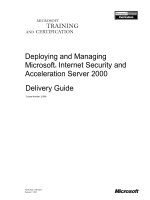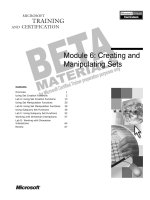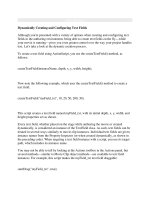Creating and Managing Tables potx
Bạn đang xem bản rút gọn của tài liệu. Xem và tải ngay bản đầy đủ của tài liệu tại đây (174.66 KB, 33 trang )
9
Copyright © Oracle Corporation, 2001. All rights reserved.
Creating and Managing Tables
9-2
Copyright © Oracle Corporation, 2001. All rights reserved.
Objectives
After completing this lesson, you should be able to
do the following:
•
Describe the main database objects
•
Create tables
•
Describe the data types that can be used when
specifying column definition
•
Alter table definitions
•
Drop, rename, and truncate tables
9-3
Copyright © Oracle Corporation, 2001. All rights reserved.
Database Objects
Object Description
Table Basic unit of storage; composed of rows
and columns
View Logically represents subsets of data from
one or more tables
Sequence Numeric value generator
Index Improves the performance of some queries
Synonym Gives alternative names to objects
9-4
Copyright © Oracle Corporation, 2001. All rights reserved.
Naming Rules
Table names and column names:
•
Must begin with a letter
•
Must be 1–30 characters long
•
Must contain only A–Z, a–z, 0–9, _, $, and #
•
Must not duplicate the name of another object
owned by the same user
•
Must not be an Oracle server reserved word
9-5
Copyright © Oracle Corporation, 2001. All rights reserved.
The CREATE TABLE Statement
•
You must have:
–
CREATE TABLE privilege
–
A storage area
•
You specify:
–
Table name
–
Column name, column data type, and column size
CREATE TABLE [schema.]table
(column datatype [DEFAULT expr][, ]);
9-6
Copyright © Oracle Corporation, 2001. All rights reserved.
Referencing Another User’s Tables
•
Tables belonging to other users are not in the
user’s schema.
•
You should use the owner’s name as a prefix to
those tables.
9-7
Copyright © Oracle Corporation, 2001. All rights reserved.
The DEFAULT Option
•
Specify a default value for a column during an
insert.
•
Literal values, expressions, or SQL functions are
legal values.
•
Another column’s name or a pseudocolumn are
illegal values.
•
The default data type must match the column data
type.
hire_date DATE DEFAULT SYSDATE,
9-8
Copyright © Oracle Corporation, 2001. All rights reserved.
•
Create the table.
•
Confirm table creation.
Creating Tables
CREATE TABLE dept
(deptno NUMBER(2),
dname VARCHAR2(14),
loc VARCHAR2(13));
Table created.
Table created.
DESCRIBE dept
9-9
Copyright © Oracle Corporation, 2001. All rights reserved.
Tables in the Oracle Database
•
User Tables:
–
Are a collection of tables created and maintained
by the user
–
Contain user information
•
Data Dictionary:
–
Is a collection of tables created and maintained by
the Oracle Server
–
Contain database information
9-10
Copyright © Oracle Corporation, 2001. All rights reserved.
SELECT table_name
FROM user_tables ;
SELECT *
FROM user_catalog ;
Querying the Data Dictionary
•
View distinct object types owned by the user.
•
View tables, views, synonyms, and sequences owned by
the user.
SELECT DISTINCT object_type
FROM user_objects ;
•
See the names of tables owned by the user.
9-11
Copyright © Oracle Corporation, 2001. All rights reserved.
Data Types
Data Type Description
VARCHAR2(size) Variable-length character data
CHAR(size) Fixed-length character data
NUMBER(p,s) Variable-length numeric data
DATE Date and time values
LONG Variable-length character data
up to 2 gigabytes
CLOB Character data up to 4
gigabytes
RAW and LONG RAW Raw binary data
BLOB Binary data up to 4 gigabytes
BFILE Binary data stored in an external
file; up to 4 gigabytes
ROWID A 64 base number system representing
the unique address of a row in its table.
9-13
Copyright © Oracle Corporation, 2001. All rights reserved.
DateTime Data Types
Data Type Description
TIMESTAMP Date with fractional seconds
INTERVAL YEAR TO MONTH Stored as an interval of years
and months
INTERVAL DAY TO SECOND Stored as an interval of days to
hours minutes and seconds
Datetime enhancements with Oracle9i:
•
New Datetime data types have been introduced.
•
New data type storage is available.
•
Enhancements have been made to time zones
and local time zone.
9-14
Copyright © Oracle Corporation, 2001. All rights reserved.
DateTime Data Types
•
The TIMESTAMP data type is an extension of the
DATE data type.
•
It stores the year, month, and day of the DATE
data type, plus hour, minute, and second values
as well as the fractional second value.
•
The TIMESTAMP data type is specified as follows:
TIMESTAMP[(fractional_seconds_precision)]
9-15
Copyright © Oracle Corporation, 2001. All rights reserved.
TIMESTAMP WITH TIME ZONE Data Type
•
TIMESTAMP WITH TIME ZONE is a variant of
TIMESTAMP that includes a time zone
displacement in its value.
•
The time zone displacement is the difference, in
hours and minutes, between local time and UTC.
TIMESTAMP[(fractional_seconds_precision)]
WITH TIME ZONE
9-16
Copyright © Oracle Corporation, 2001. All rights reserved.
TIMESTAMP WITH LOCAL TIME Data Type
•
TIMESTAMP WITH LOCAL TIME ZONE is another
variant of TIMESTAMP that includes a time
zone displacement in its value.
•
Data stored in the database is normalized to the
database time zone.
•
The time zone displacement is not stored as part
of the column data; Oracle returns the data in
the users' local session time zone.
•
TIMESTAMP WITH LOCAL TIME ZONE data type is
specified as follows:
TIMESTAMP[(fractional_seconds_precision)]
WITH LOCAL TIME ZONE
9-17
Copyright © Oracle Corporation, 2001. All rights reserved.
INTERVAL YEAR TO MONTH Data Type
•
INTERVAL YEAR TO MONTH stores a period of time
using the YEAR and MONTH datetime fields.
INTERVAL YEAR [(year_precision)] TO MONTH
INTERVAL '123-2' YEAR(3) TO MONTH
Indicates an interval of 123 years, 2 months.
INTERVAL '123' YEAR(3)
Indicates an interval of 123 years 0 months.
INTERVAL '300' MONTH(3)
Indicates an interval of 300 months.
INTERVAL '123' YEAR
Returns an error, because the default precision is 2,
and '123' has 3 digits.
9-18
Copyright © Oracle Corporation, 2001. All rights reserved.
INTERVAL DAY TO SECOND Data Type
•
INTERVAL DAY TO SECOND stores a period of time in
terms of days, hours, minutes, and seconds.
INTERVAL DAY [(day_precision)]
TO SECOND [(fractional_seconds_precision)]
INTERVAL '4 5:12:10.222' DAY TO SECOND(3)
Indicates 4 days, 5 hours, 12 minutes, 10 seconds,
and 222 thousandths of a second.INTERVAL '123' YEAR(3).
INTERVAL '7' DAY
Indicates 7 days.
INTERVAL '180' DAY(3)
Indicates 180 days.
9-19
Copyright © Oracle Corporation, 2001. All rights reserved.
INTERVAL DAY TO SECOND Data Type
•
INTERVAL DAY TO SECOND stores a period of time in
terms of days, hours, minutes, and seconds.
INTERVAL '4 5:12:10.222' DAY TO SECOND(3)
Indicates 4 days, 5 hours, 12 minutes, 10 seconds,
and 222 thousandths of a second.
INTERVAL '4 5:12' DAY TO MINUTE
Indicates 4 days, 5 hours and 12 minutes.
INTERVAL '400 5' DAY(3) TO HOUR
Indicates 400 days 5 hours.
INTERVAL '11:12:10.2222222' HOUR TO SECOND(7)
indicates 11 hours, 12 minutes, and 10.2222222 seconds.
9-20
Copyright © Oracle Corporation, 2001. All rights reserved.
Creating a Table
by Using a Subquery Syntax
•
Create a table and insert rows by combining the
CREATE TABLE statement and the AS subquery option.
•
Match the number of specified columns to the number
of subquery columns.
•
Define columns with column names and
default values.
CREATE TABLE table
[(column, column )]
AS subquery;
9-21
Copyright © Oracle Corporation, 2001. All rights reserved.
Creating a Table by Using a Subquery
DESCRIBE dept80
CREATE TABLE dept80
AS
SELECT employee_id, last_name,
salary*12 ANNSAL,
hire_date
FROM employees
WHERE department_id = 80;
Table created.
Table created.
9-22
Copyright © Oracle Corporation, 2001. All rights reserved.
The ALTER TABLE Statement
Use the ALTER TABLE statement to:
•
Add a new column
•
Modify an existing column
•
Define a default value for the new column
•
Drop a column
9-23
Copyright © Oracle Corporation, 2001. All rights reserved.
The ALTER TABLE Statement
Use the ALTER TABLE statement to add, modify, or
drop columns.
ALTER TABLE table
ADD (column datatype [DEFAULT expr]
[, column datatype] );
ALTER TABLE table
MODIFY (column datatype [DEFAULT expr]
[, column datatype] );
ALTER TABLE table
DROP (column);
9-24
Copyright © Oracle Corporation, 2001. All rights reserved.
Adding a Column
DEPT80
“Add a new
column to the
DEPT80
table.”
DEPT80
New column
9-25
Copyright © Oracle Corporation, 2001. All rights reserved.
Adding a Column
•
You use the ADD clause to add columns.
•
The new column becomes the last column.
ALTER TABLE dept80
ADD (job_id VARCHAR2(9));
Table altered.
Table altered.
9-26
Copyright © Oracle Corporation, 2001. All rights reserved.
Modifying a Column
•
You can change a column’s data type, size, and
default value.
•
A change to the default value affects only
subsequent insertions to the table.
ALTER TABLE dept80
MODIFY (last_name VARCHAR2(30));
Table altered.
Table altered.









